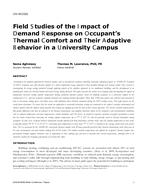Description
According to the adaptive approach for thermal comfort, such as described for occupant controlled, naturally conditioned spaces in ASHRAE Standard 55-2013, occupants may find thermal comfort in a wider temperature range compared to that specified through heat balance model. Our research is investigating the energy savings potential through applying aspects of the adaptive approach to air conditioned buildings and the development of an optimization scheme for thermal comfort with peak energy cooling demand. This paper presents the results of an ongoing study investigating the impact of temporarily increased cooling setpoint temperature during simulated demand response events on building occupants at a university campus in the southeastern U.S., and the occupant’s adaptive behaviors for reducing thermal discomfort. More than 1500 data points were collected and analyzed to date in classrooms, dining spaces and lobby areas, with additional data collection conducted during the 2017 cooling season. This paper focuses on the results from classrooms. To ensure that the results are applicable to real-world situations, testing was conducted in the subject’s everyday environment and normal routines with the subjects being unaware that testing was ongoing up until the time of their survey questions. The surveys recorded human factors like gender differences and time of exposure to the thermal environment, any adaptive behaviors taken by the occupant’s, and environmental conditions such as ambient temperature and zone temperatures, relative humidity, and CO2 levels. As would be expected, variations in people’s perceptions existed, but the results showed that increasing the cooling setpoint temperature up to 77° F (25° C) did not generally result in thermal discomfort among occupants. In some cases, occupant thermal satisfaction actually improved for those preferring a warmer room, since the setpoint temperature in these zones is typically around 70-72° F or 21-22° C. Increasing zone temperatures to more than 77° F (25° C) resulted in the average actual mean vote greater than +0.5 as measured by the ASHRAE seven-point thermal comfort scale. Women generally perceived their thermal environment cooler than men in the same environment and with similar clothing level (CLO value). The outdoor ambient temperature also affected the occupant’s thermal comfort vote, presumably through adaptive behaviors such as adjustment to their clothing type and level or possibly their overall expectations, although there is no conclusive evidence for changing expectations so far from this study.
Citation: 2018 Winter Conference, Chicago, IL, Conference Papers
Product Details
- Published:
- 2018
- Number of Pages:
- 10
- Units of Measure:
- Dual
- File Size:
- 1 file , 500 KB
- Product Code(s):
- D-CH-18-C022




